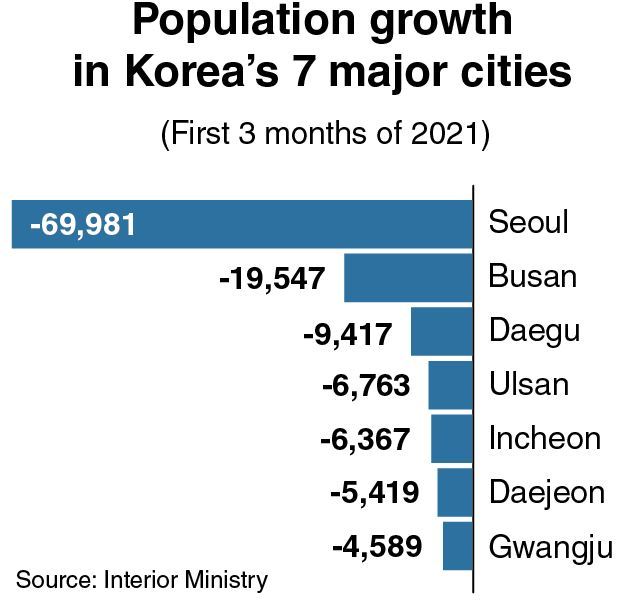
A woman enjoys surfing on the sea off Songjeong Beach in Busan, where the population has continued to decline since February 2016. (Yonhap)
SEJONG South Korea’s seven major cities are leading the nation’s population decline, with the nation’s largest and second-largest cities Seoul and Busan particularly posting negative growth in the demographic tally for several years.
According to the Ministry of Interior and Safety, the nation’s seven major cities saw the population decrease by 122,083 collectively for the first three months of the year.
This marked the highest decline since the nation faced a downhill trend in the monthly demographic tally in December 2019.

Seoul topped the list, as the capital posted minus 69,981 during the first quarter losing 10,496 in January, 9,363 in February and 50,122 in March. Its population fell to 9.59 million, which is the lowest in more than three decades, since the mid-1980s.
Busan ranked No. 2 with minus 19,547, where the population has posted negative growth for 62 consecutive months since February 2016. The number of residents in the city fell by about 140,000 from 3.51 million in January 2016 to 3.37 million in March 2021.
Next on the list were Daegu with minus 9,417 over the corresponding period, followed by Ulsan with minus 6,763, Incheon with minus 6,367, Daejeon with minus 5,419 and Gwangju with minus 4,589.
This represents falling marriage rates and record-low fertility rates, though still many young people, born in rural areas, have been moving to metropolitan cities for studying, working and living.
In Seoul, residents, aged 70-79 outnumbered those aged under 10 by 6.98 million vs. 6.11 million as of March.
The same trend is also seen in Busan by 2.93 million for those in their 70s vs. 2.28 million for those under 10, and Daegu by 1.76 million vs. 1.75 million. The other four cities are projected to follow suit in the coming years.
By age group nationwide, those in their 50s accounted for the highest portion, 16.6 percent (8.61 million), of the entire population of 51.705 million, which is hinting that the nation is heading toward being a superaged society, from the current aged society.
Ranking next were those in their 40s with a portion of 15.9 percent (8.25 million) of the population.
A worrisome point in terms of securing a working-age population is that those in their 60s overtook those in their 30s this year by 6.87 million (13.2 percent) vs. 6.81 million (13.1 percent) for the first time here.
In the portion, those in their 60s, while about half of these are classified as seniors aged 65 or over, far outstripped those in their 20s (13 percent with 6.76 million), those aged 10-19 (9.2 percent with 4.76 million) and those aged under 10 (7.5 percent with 3.9 million).
People in their 80s or over made up 3.9 percent (2.02 million) of the population last month.
Women outnumbered men in the nation by 131,125, or 25.918 million vs. 25.787 million.
In Korea, the female population overtook the male population about six years ago. The changeover took place in June 2015, when the number of men per 100 women fell to 99.9 or by 25.7153 million men to 25.7157 million women.
That was the first time the gender ratio had slid below 100 since the nation began compiling the relevant figures.
The ratio has further dropped by about 0.1 percentage point per annum over the past years 99.7 in March 2018, 99.6 in March 2019, 99.5 in March 2020 and 99.4 in March 2021. By Kim Yon-se (kys@heraldcorp.com)
Words in This Article
collectively - adv. as a group
corresponding - adj. caused by or connected with something you have already mentioned
fertility - n. the ability of a person, animal, or plant to produce babies, young animals, or seeds
outnumber - v. to be more in number than another group
per annum- adv. for each year
Comprehension Quiz
What is the article mainly about?
According to the Ministry of Interior and Safety, what is going on with the population in Korea?
Where are the seven major cities in Korea?
What can you tell about the graph, 'Population growth in Korea's 7 major cities'?